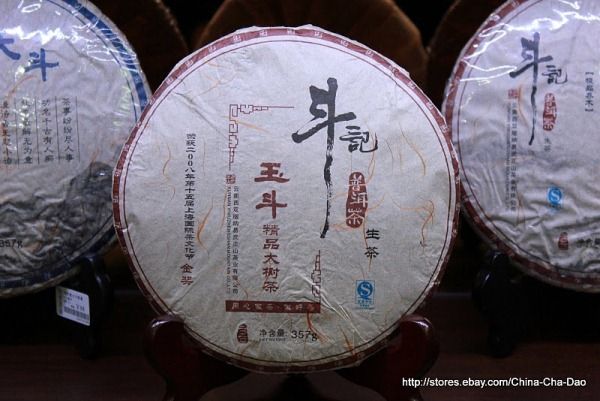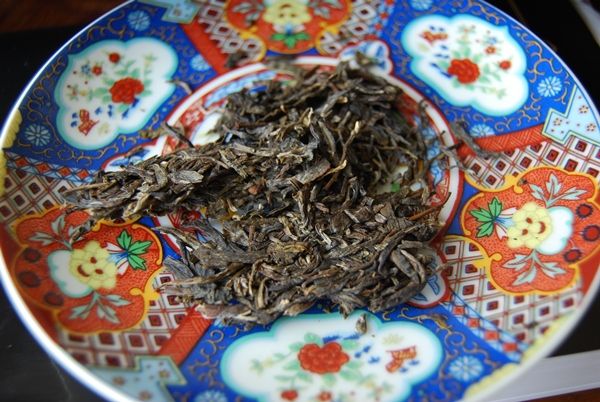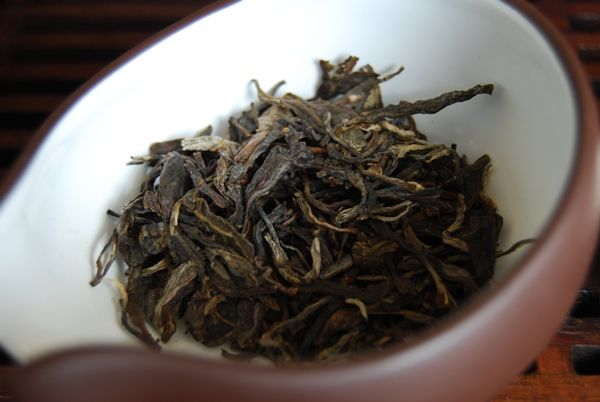Douji are a reliable outfit. Their mainstream, lower-tier cakes are enjoyable, accomplished blends, and their upper-tier cakes (usually single-mountain cakes) are very solid examples.
Thanks, then, to the mighty TD for providing a sample of a blend that is entirely new to me: the "Yudou", where "yu" is "jade" (and "dou" refers to the label - and is approximately pronounced "doh"!).
I think this cake came from China Chadao, but I can find only mini-bricks available, which are priced around $5, as are most of them (with the exception of the "Jindou" brick at double the price). I'm sure a quick trip to Taobao would bring up the bingcha, should you be inclined.
This blend is about eclectic as one can get without leaving Yunnan: it has four sources.
The first three are scattered around Xishuangbanna: Youleshan (in Mengla, south-eastern 'Banna, near Laos), Hekaishan (in the Nannuo region, in central-south 'Banna), and Mengsongshan (in far south of 'Banna, near Burma). The fourth is from good old Mengkushan (in Shuangjiang region, which is far to the north in Lincang prefecture).
I rather enjoy blended tea, as I'm not entirely certain how much history single-mountain cakes have accumulated. Plenty of the old classics are, for example, blends. I remember wondering aloud in the past if our merchants that select their own tea (Yunnan Sourcing, Essence of Tea, Dragon Teahouse, Puerh Shop, etc.) might venture into the world of blending. Then again, it might be said with some justification that blending is something of an art-form, and is probably more difficult than selecting good-quality maocha from a single area. As we know, many of the modern mainstream factories were founded by blenders of Menghai Tea Company, keen to strike out on their own. Blending must be rather artful.
As shown above, the leaves in this blend look very healthy. The husky yellow soup, shown below, reassures us that blending has not taken place with a consequent fiddling of the leaves to make them more immediately appealing - it is an honest, raw colour.
The aroma is similarly healthy: dry grains, then plenty of buttery finishing scents.
The blend packs in a great deal of complex, complementary characteristics: there is a thick tobacco base, some tartness, good kuwei [bitterness], and even chubby, granary Lincang flavours may be picked out. The various components come together well. Assuming that these are plantation leaves, the result is stable, complex, and highly enjoyable.
You never know, its raw state, complex base of low flavours, and potency might allow it to age well.





Hobbes:
ReplyDeletePuehr Shop made a 7542 blend in 2009. I enjoyed it the last time I tried it.
Regards,
Karl
Mengsong is actually between Jinghong and Menghai. Hekai, Naka and Nannuo are technically Mengsong area teas. Naka is north of Menghai and Jinghong. Nannuo is slightly south, and Hekai farther south than Nannuo, if I recall correctly. (problem is, so many villages in XSBN have the same name!)
ReplyDeleteWe're talking the Xiao Mengsong, which is on the border to Myanmar. It's a bit to the east of the bulang area Man Nuo by about 50 miles. It's not normally referred to because there isn't really much ancient arbor there and the tea isn't that special, comparable to many areas in Banna that we do not normally hear about. Bannablog (in french) has an interesting article on (xiao)mengsong.
ReplyDeleteIt's interesting to think of Naka and Hekai both as Mengsong tea.
--shah8
At the risk of prolonging the discussion, while Naka is sometimes sold as Mengsong (ref. Nada's articles), Hekai is at the northern end of the Nannuo region, according to Scott and China Chadao. Not that it's an important fact ;)
ReplyDeleteAll the best,
Hobbes
I've just had it demonstrated to me that Hekai is south of Nannuo )
ReplyDeleteDear Hobbes,
ReplyDeleteChina cha dao sells the yu dou 2010 cake for 29.99 (though it says 7 available only) and the 2011 version for 26.99, a reasonable price level, I'd say, and one which, as far as I can tell, corresponds well to tao bao-prices.
I also got a sample from Jerry last year and I found it to be quite impressive, considering the price, though I haven't yet decided whether to buy more. I better try this years version first, I think.
I also wanted to point out that Scott (YS) actually offers two recipe cakes from his own label this year: the 2011 Shang Chun and the 2011 Chen Yun Yuan Cha. I haven't tried them yet, but they should be in the mail as we speak. It will be very interesting to see what he has come up with.
Best wishes
Johan
Dear Johan,
ReplyDeleteThanks for the data! I'd not noticed Scott's blends, having only taken his top three for sampling this year - I'll get back to his website and see what's available.
All the best,
Hobbes